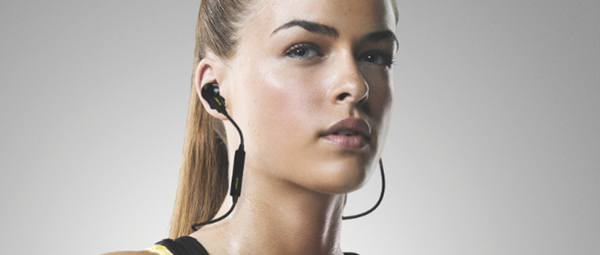
Jabra’s Sport Pulse
Jabra has released its latest pair of headphones this week that can read your pulse through your ears and tell you if you’ve exercised too much.
The wireless headphones use an optomechanical sensor that uses light to detect the pulse in your ear and oxygen consumption, which the firm claim have proved accurate to within 99.2% compared to a medical electrocardiogram.
The £199 headphones are compatible with the Jabra Sport Life smartphone app, which can interface with most sports tracking apps including Endomondo, Map My Run and Runtastic.
Unlike most other running apps, however, the Android and iOS app can tell you your VO2Max level and allow you to take orthostatic heart rate tests, which assess whether you’re training too much.
The Sport Life app also offers audio coaching, telling you to speed up or slow down, and lets you make offline playlists from YouTube.
The Jabra Sport Pulse, expected to launch in October, is also sweat and water proof and includes 4.5 hours of battery life.
LG’s Heart Rate Earphones
In May, LG launched its Heart Rate Earphones in the US, which track heart rate and oxygen consumption while exercising.
Unveiled at the 2014 Consumer Electronics Show, the earphones include a PerformTek sensor that measures the flow of blood in the outer ear to capture biometric data like your heart rate and oxygen consumption.
A clip-on medallion connected to the earphones provides Bluetooth connectivity, which sends data to an iOS or Android smartphone into an LG Fitness app, or other apps, such as MapMyFitness.
The device can also be paired with LG’s Lifeband Touch, which is a wrist-worn device that automatically turns on when the wearer turns their wrist.
The LG Heart Rate Earphones are still yet to make it to UK shores.
FreeWavz
Hitting the market later this year are also wireless earphones from FreeWavz, which claim to track a number of fitness metrics as they sit stably in your ear.
The Kickstarter-backed headset monitors steps taken, calories burned, average speed, heart rate and more. The data is sent on to the users’ mobile device, providing audible health statistics in real-time.
Developed by ear, nose and throat surgeon Eric Hensen of Lakeland, they’re designed in a way so that one can hear both music and environmental sounds, such as cars approaching, at once.
The earphones work independently of each other, meaning there’s no cord attaching the two pieces together.
They’re sweat and water proof, and come equipped with microphones for answering calls and calendar alerts – all while listening to music.
The Melbourne-based company is now taking pre-orders via its FreeWavz online store, with a blue set costing $219, or pink for $249.
SMS Audio
Intel and 50 Cent’s accessories firm SMS Audio released smart headphones earlier this month, which they claim can measure your heart rate and tell you how far you’ve run.
The SMS BioSport In-Ear headphone set are battery-free and instead draw energy from your phone through its audio jack, which Intel claims is the first of its kind to do so.
The headphones, which are based on the same prototype technology that Intel showed off at CES in January, integrate with biometric sensors that monitor blood flow through the skin to measure a user’s heart rate during exercise.
Users are able to view the data using the popular RunKeeper app, which is monitored using a smartphone’s GPS system.
The device is also resistant to perspiration and other forms of moisture, while other feature include a patented ear-hook design in efforts to provide a comfortable fit.
Intel, which acquired fitness-band maker Basis Science in March, said the headphones are part of the chipmaker’s push into wearables.
Apple’s Lightning headphones
Now that Apple spent $3bn on Beats Electronics, the headphone maker co-founded by the hip-hop star Dr Dre, they could very well make another splash into the market.
Claims have been mounting that the iPhone maker is about to release headphones with a built-in monitoring system that would detect temperature, perspiration and heart rate.
Back in May, a post on anonymous secret-sharing app Secret said the ‘earpods’ would use Apple’s iBeacon technology to locate them if they get misplaced.
"They will require the Lightning port, it’s why the audio jack was moved to the bottom," it wrote.
Apple also revealed at this year’s WWDC the headphone module to developers, which would allow compatible headphones to plug into and iOS device’s Lightning port rather than the 3.5mm audio jack.
This would mean improved volume and playback controls and more bandwidth among other benefits.
Apple also recently hired former MIT researcher Eric Winokur as a Sensing Hardware engineer, who is known for his work on wearable medical devices, including ear-worn sensors for cardiovascular monitoring.






